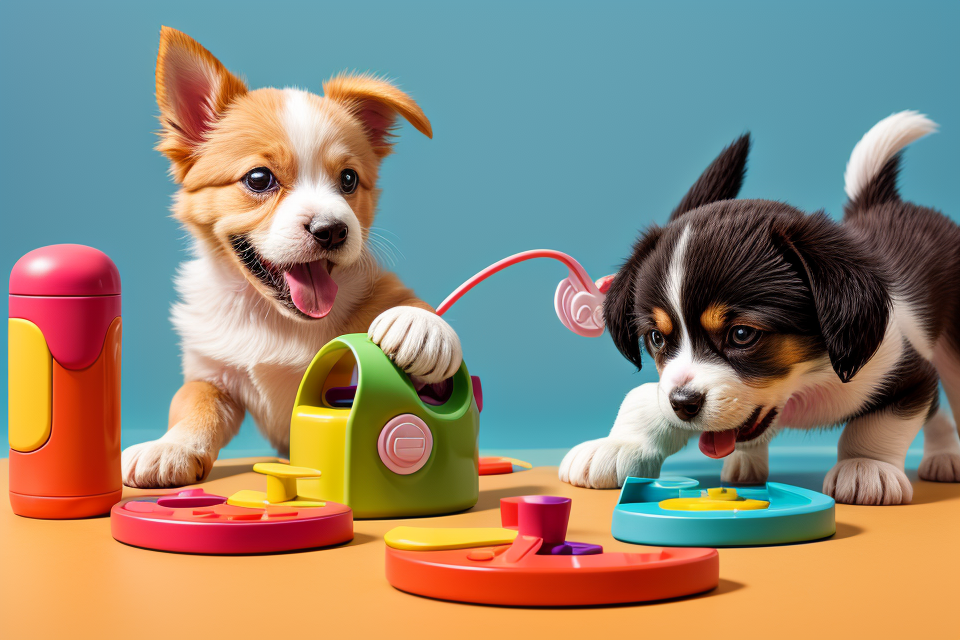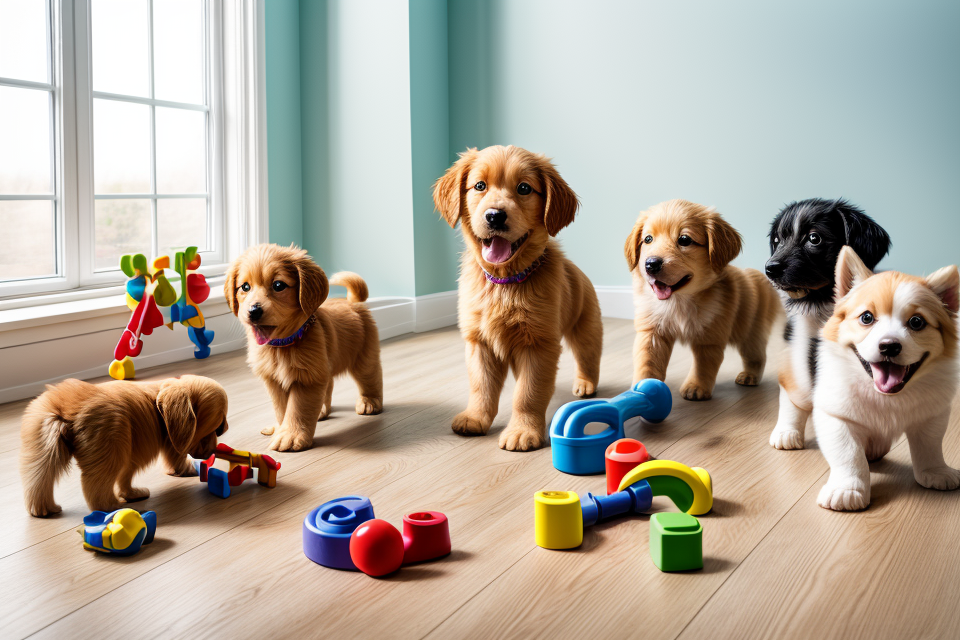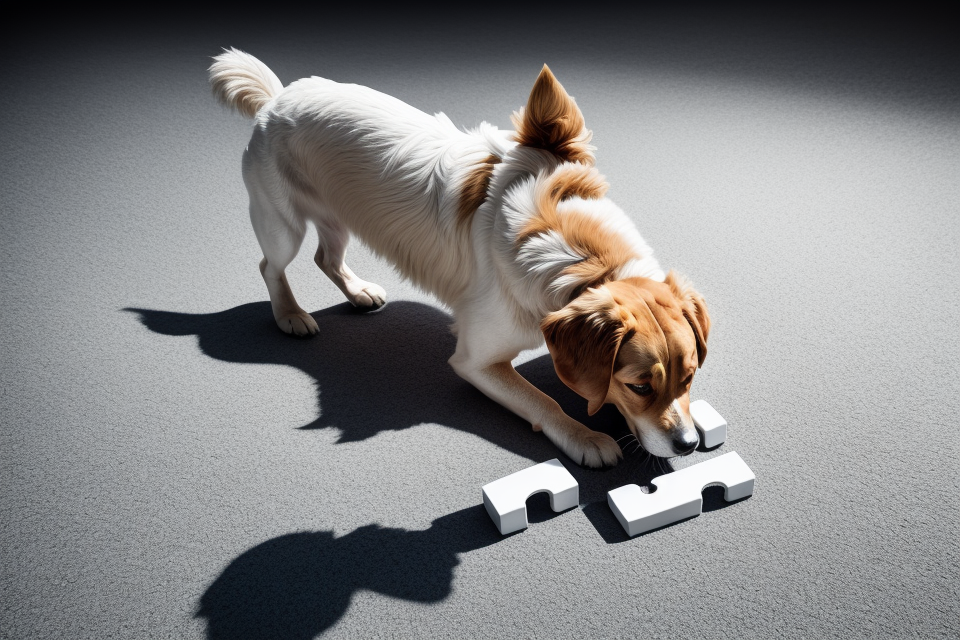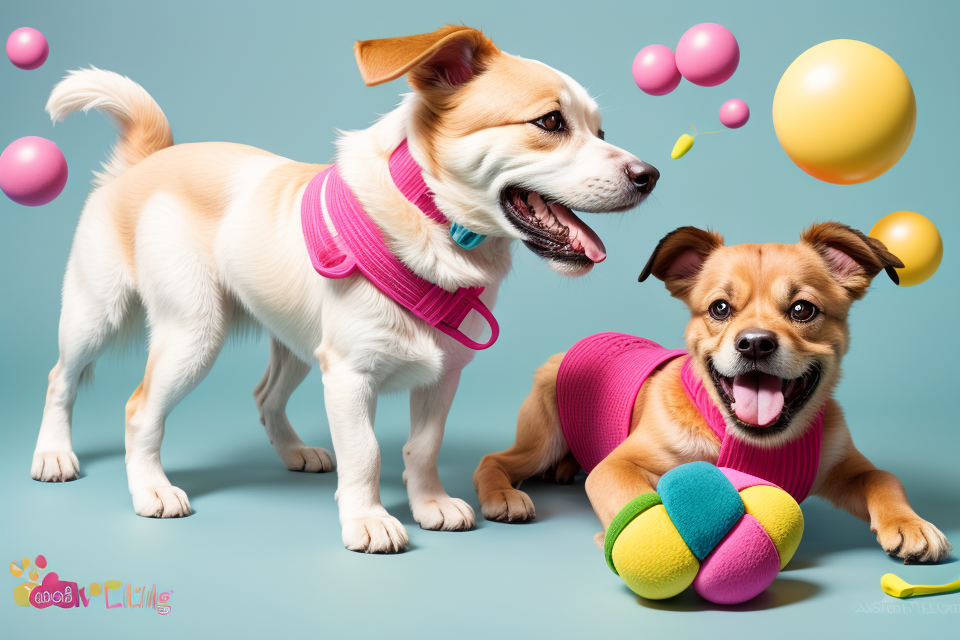Puppies are known for their boundless energy and insatiable curiosity. As they grow and develop, it’s important to provide them with appropriate ways to channel their energy and stimulate their minds. Puzzle feeders, also known as food puzzles, are a popular tool used by many dog owners to keep their puppies mentally and physically active. But are puzzle feeders really an effective way to train puppies? In this article, we’ll explore the pros and cons of using puzzle feeders as a training tool for puppies, and help you make an informed decision about whether they’re right for your furry friend. So, buckle up and get ready to discover the ins and outs of puzzle feeders for puppies!
Puzzle feeders can be an effective way to train puppies, as they encourage mental stimulation and problem-solving skills. By hiding treats or food inside a toy that the puppy must figure out how to access, puzzle feeders provide a fun and engaging way to teach puppies how to use their minds to solve problems. This can help with training and obedience, as well as reducing boredom and destructive behavior. However, it’s important to remember that puppies are still learning and may need guidance and supervision when using puzzle feeders, and that they should always have access to plenty of fresh water and a balanced diet.
The Benefits of Puzzle Feeders for Puppies
Enhances Problem-Solving Skills
Puzzle feeders are a great tool for puppies to enhance their problem-solving skills. By using puzzle feeders, puppies are able to exercise their cognitive abilities in a fun and engaging way.
Improves Cognitive Abilities
Puzzle feeders help puppies improve their cognitive abilities by challenging them to figure out how to access their food. This process requires puppies to use their memory, attention, and perception skills, all of which are crucial for cognitive development.
Develops Patience and Persistence
In addition to improving cognitive abilities, puzzle feeders also help puppies develop patience and persistence. Puppies must be patient and persistent in order to figure out how to access their food, which helps them learn important life skills such as perseverance and determination.
Overall, puzzle feeders are an effective way to enhance puppies’ problem-solving skills and cognitive abilities while also developing important life skills such as patience and persistence.
Encourages Physical Activity
Benefits of Physical Activity for Puppies
Physical activity is crucial for puppies’ growth and development. It helps build strong bones, muscles, and a healthy heart. Furthermore, it helps burn off excess energy, preventing hyperactivity and destructive behavior.
Mental Stimulation through Physical Activity
Puzzle feeders provide a form of mental stimulation for puppies, as they must figure out how to access their food. This type of mental stimulation is essential for preventing boredom and reducing the likelihood of developing behavioral problems later in life.
Reduces Boredom and Destructive Behavior
Boredom can lead to destructive behavior in puppies, such as chewing on furniture or shoes. Puzzle feeders provide an engaging and entertaining way to keep puppies mentally stimulated, reducing the likelihood of them becoming bored and destructive.
Maintains a Healthy Weight
Puzzle feeders can help maintain a healthy weight in puppies by controlling the amount of food they consume. Puppies that eat too quickly or consume too much food at one time may become overweight or obese, leading to a host of health problems. Puzzle feeders slow down the eating process, allowing puppies to feel fuller for longer periods, reducing the likelihood of overeating.
Strengthens the Bond between Puppy and Owner
Increases Interaction and Communication
One of the primary benefits of using puzzle feeders for puppies is that it increases interaction and communication between the puppy and its owner. Puzzle feeders require the puppy to solve a problem or complete a task in order to receive a reward, which encourages the puppy to communicate with its owner and seek their guidance. This increased interaction can help strengthen the bond between the puppy and its owner, as it fosters a sense of trust and mutual understanding.
Fosters Positive Reinforcement
Another benefit of using puzzle feeders for puppies is that it fosters positive reinforcement. Puzzle feeders reward puppies for good behavior, such as completing a task or solving a problem, which encourages positive reinforcement. Positive reinforcement is a powerful tool in dog training, as it reinforces desired behaviors and helps puppies learn what is expected of them. By using puzzle feeders, puppies are able to learn and understand what behaviors are rewarded, which can help them develop good habits and behaviors.
Overall, puzzle feeders can be an effective way to train puppies, as they provide a fun and engaging way to teach puppies new skills and behaviors. By strengthening the bond between the puppy and its owner and fostering positive reinforcement, puzzle feeders can help puppies learn and grow in a positive and supportive environment.
How to Choose the Right Puzzle Feeder for Your Puppy
Factors to Consider
When choosing a puzzle feeder for your puppy, there are several factors to consider. Here are some of the most important ones:
Size and Age of the Puppy
The size and age of your puppy should be the first consideration when choosing a puzzle feeder. Smaller puppies may have difficulty accessing food from larger puzzle feeders, so it’s important to choose one that’s appropriate for their size. Additionally, younger puppies may need simpler puzzle feeders that are easier for them to figure out.
Type of Puzzle Feeder
There are many different types of puzzle feeders available, each with their own unique features and challenges. Some puzzle feeders require the puppy to push or pull pieces to release food, while others require them to solve a problem or complete a task. Consider your puppy’s personality and interests when choosing a puzzle feeder, as well as their current level of cognitive development.
Durability and Material
Puzzle feeders can be made from a variety of materials, including plastic, metal, and rubber. Choose a durable material that can withstand the chewing and biting of a puppy. Additionally, consider the safety of the material, as some puppies may be able to chew through certain materials and potentially ingest pieces of the puzzle feeder.
Price and Budget
Puzzle feeders can range in price from a few dollars to several hundred dollars. Consider your budget when choosing a puzzle feeder, but keep in mind that a higher price may mean a higher quality product that will last longer and provide more challenges for your puppy.
Overall, when choosing a puzzle feeder for your puppy, it’s important to consider their size, age, personality, and cognitive development, as well as the durability and material of the puzzle feeder, and your budget.
Tips for Introducing Puzzle Feeders to Your Puppy
Encouraging Playtime
One of the best ways to introduce puzzle feeders to your puppy is by encouraging playtime. Here are some tips to make it a fun experience for your furry friend:
Make it a Fun Experience
- Use different types of puzzle feeders: There are various types of puzzle feeders available in the market, such as treat-dispensing toys, hide-and-seek toys, and interactive puzzles. Experiment with different types of puzzle feeders to keep your puppy engaged and interested.
- Add treats and toys: In addition to using puzzle feeders, you can also add treats and toys to the mix. This will make the experience more exciting and rewarding for your puppy.
- Use positive reinforcement: Use positive reinforcement techniques such as praise, petting, and rewards to reinforce good behavior. This will encourage your puppy to engage in playtime and associate it with positive experiences.
Offer Praise and Rewards
- Give praise: Praise your puppy when they successfully figure out how to use the puzzle feeder. This will encourage them to keep trying and will boost their confidence.
- Offer rewards: Reward your puppy with treats or toys when they successfully use the puzzle feeder. This will reinforce good behavior and will encourage them to continue using the puzzle feeder.
Overall, introducing puzzle feeders to your puppy can be a fun and rewarding experience. By making it a fun experience, offering praise and rewards, and encouraging playtime, you can help your puppy develop problem-solving skills and mental stimulation.
Common Puzzle Feeder Mistakes to Avoid
Overloading the Puzzle Feeder
When using puzzle feeders as a training tool for puppies, it is important to avoid overloading the feeder with too much food. Not only can this lead to the puppy becoming overwhelmed and discouraged, but it can also result in the feeder becoming jammed or stuck, making it difficult for the puppy to access the food.
Too Much Food at Once
One common mistake when using puzzle feeders is to put too much food in the feeder at once. This can be especially tempting when using puzzle feeders as a way to slow down a puppy’s eating, as it may seem like a good idea to put a large amount of food in the feeder to make it last longer. However, this can quickly become overwhelming for the puppy, who may become stressed or even sick if they eat too much food at once.
Difficulty Levels that are too High
Another mistake to avoid when using puzzle feeders is setting the difficulty level too high. While puzzle feeders are designed to challenge puppies and slow down their eating, it is important to start with a level that is appropriate for the puppy’s skill level. If the difficulty level is too high, the puppy may become frustrated and give up on trying to solve the puzzle, which can actually hinder their training rather than helping it.
It is important to remember that puzzle feeders are just one tool in the training process, and should be used in conjunction with other training techniques, such as positive reinforcement and socialization. By avoiding these common mistakes and using puzzle feeders appropriately, puppy owners can help their furry friends develop important problem-solving skills and improve their overall behavior and well-being.
Neglecting Supervision
Neglecting supervision is one of the most common mistakes made when using puzzle feeders as a training tool for puppies. This can occur in two ways: leaving your puppy unattended while they are trying to solve the puzzle feeder, and not monitoring your puppy’s progress as they attempt to figure out how to access the food.
Leaving Your Puppy Unattended
Leaving your puppy unattended while they are trying to solve the puzzle feeder can be dangerous. Some puzzle feeders are designed to be difficult to open, and if your puppy becomes frustrated or scared while trying to solve it, they may chew on the feeder or become aggressive. It is important to supervise your puppy at all times when they are using a puzzle feeder, to ensure their safety and prevent any damage to the feeder.
Not Monitoring Your Puppy’s Progress
Not monitoring your puppy’s progress as they attempt to solve the puzzle feeder can also be detrimental to their training. It is important to observe your puppy’s behavior and adjust the difficulty of the puzzle feeder as needed. If your puppy is having too much difficulty, they may become frustrated and lose interest in the training process. On the other hand, if the puzzle feeder is too easy, your puppy may become bored and uninterested in the training. By monitoring your puppy’s progress, you can ensure that they are being challenged just enough to keep them engaged and motivated.
The Verdict on Puzzle Feeders for Puppies
When it comes to using puzzle feeders as a training tool for puppies, the verdict is still out. While some experts believe that puzzle feeders can be an effective way to train puppies, others are not convinced. In this section, we will explore the pros and cons of using puzzle feeders for puppy training, and provide some tips for making an informed decision.
Pros and Cons
One of the main advantages of using puzzle feeders for puppy training is that they can help to stimulate a puppy’s mind and prevent boredom. By providing a challenge for the puppy to solve, puzzle feeders can help to keep them engaged and mentally stimulated, which can be especially important for breeds that are prone to boredom and destructive behavior. Additionally, puzzle feeders can help to encourage problem-solving skills and critical thinking, which can be beneficial for a puppy’s overall development.
However, there are also some potential drawbacks to using puzzle feeders for puppy training. One concern is that puppies may become frustrated or discouraged if they are unable to figure out how to access the food. This can lead to a lack of interest in food or even a loss of appetite, which can be detrimental to a puppy’s health and development. Additionally, some puppies may become too focused on the puzzle feeder and neglect other important aspects of their training, such as basic obedience commands.
Making an Informed Decision
Ultimately, whether or not to use a puzzle feeder for puppy training will depend on a variety of factors, including the breed of the puppy, their age and developmental stage, and their individual personality and temperament. It is important to consider both the potential benefits and drawbacks of using a puzzle feeder, and to consult with a veterinarian or professional trainer if you have any concerns. Additionally, it is important to choose a high-quality puzzle feeder that is appropriate for your puppy’s size and strength, and to monitor their progress and adjust the difficulty level as needed. With proper care and attention, a puzzle feeder can be a useful tool for training and stimulating your puppy’s mind.
FAQs
1. What are puzzle feeders?
Puzzle feeders are toys designed for dogs that dispense food or treats when the dog interacts with the toy in a specific way. They can come in various shapes and sizes and may require the dog to push, pull, or manipulate the toy to release the food.
2. How do puzzle feeders help with training puppies?
Puzzle feeders can be an effective tool for training puppies because they encourage mental stimulation and problem-solving skills. By making the dog work for their food, puzzle feeders can help satisfy their natural instinct to forage and hunt, while also teaching them patience and persistence.
3. Are puzzle feeders good for all puppies?
Puzzle feeders can be beneficial for most puppies, but it’s important to introduce them gradually and under supervision. Some puppies may be too young or not yet coordinated enough to use a puzzle feeder effectively, while others may become frustrated or overwhelmed if the challenge is too difficult. It’s important to monitor your puppy’s behavior and adjust the difficulty level of the puzzle feeder as needed.
4. How do I choose the right puzzle feeder for my puppy?
When choosing a puzzle feeder for your puppy, consider their age, size, and level of coordination. Look for a puzzle feeder that is appropriate for their age and ability level, and that contains a small amount of food that they can easily access. You may also want to consider a puzzle feeder that can be adjusted as your puppy grows and becomes more skilled.
5. How often should I use a puzzle feeder with my puppy?
You can use a puzzle feeder with your puppy as often as you like, but it’s important to start with short sessions and gradually increase the length of time as your puppy becomes more comfortable and confident using the toy. You can also use the puzzle feeder as a reward during training sessions or as a way to provide mental stimulation when you’re not able to provide physical exercise.



